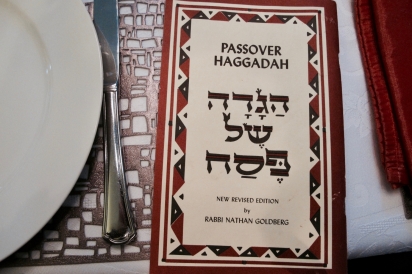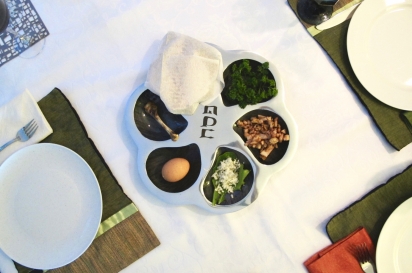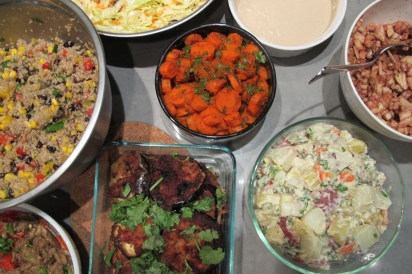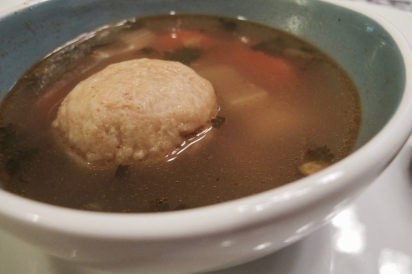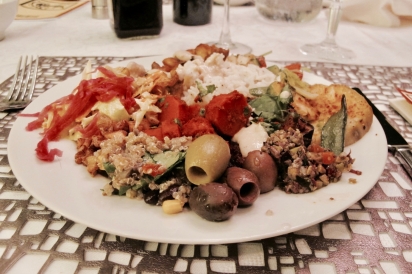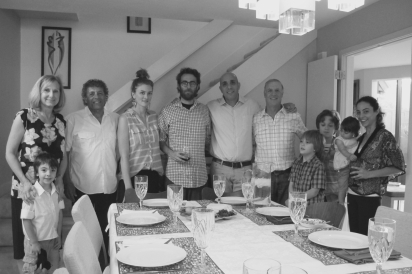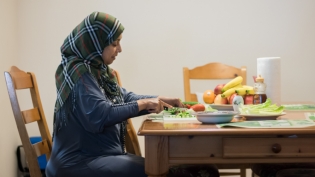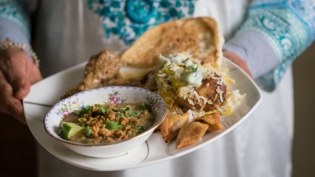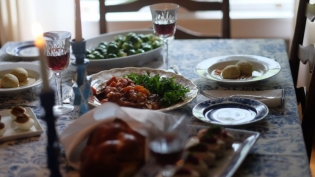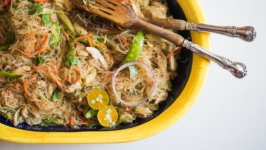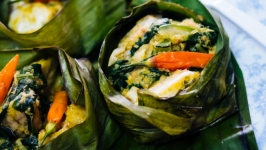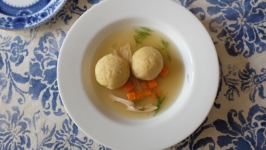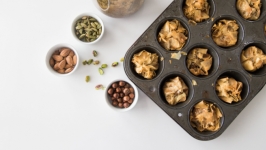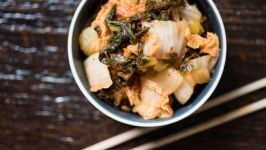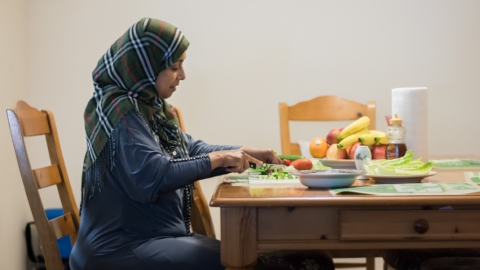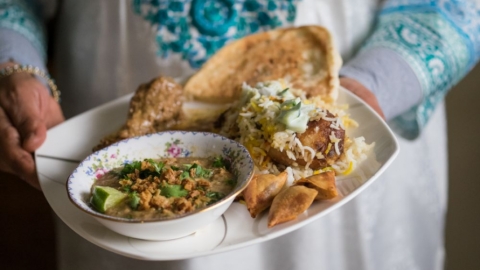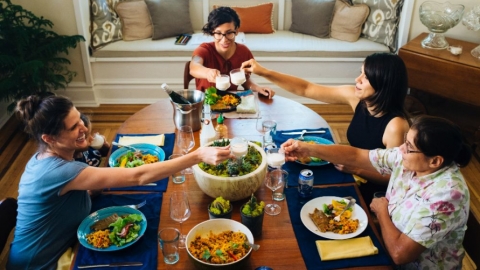Adventures in Food: My First Passover Seder
I’m not Jewish but I have recently developed quite the taste for Israeli food. About a year ago I received a copy of Zahav, Michael Solomonov’s Israeli cookbook, and found myself immersed in the cuisine of the Jewish diaspora. Mediterranean and Middle Eastern food have always been familiar to me so it wasn’t difficult to relate to the somewhat familiar dishes and ingredients. My late aunt’s husband was Greek, the two of them responsible for much of my early epicurean education, and I spent a decent amount of time in places like Crete, Bahrain and Dubai during my stint in the Navy. However, my only experience with true Israeli food was largely uninformed by any first-hand reference, comprised only of the handful of recipes recreated from Solomonov’s book. That being said, I was instantly a fan.
Another thing I’m quite fond of is learning about other cultures through first-hand experiences, particularly those centered around food. I’m willing to try nearly anything and make it a point to sample the local flavors whether in a city in America I’m visiting for the first time or a new country altogether. It’s like an initiation of sorts, a means of connecting with a people and developing a deeper understanding of who they are and their history based on the way they approach nutrition and hospitality.
When I was invited to participate in an informal Passover Seder meal, I jumped at the opportunity. Not only would I be able to stack my attempts at Israeli cooking against the real deal, but I would get a glimpse into the practices and rituals of a culture and religion that has always been just a little mysterious to me.
The Passover ritual is conducted via the Haggadah, a book that instantly reminded me of the fraternity ritual guides we used in college with their readings and symbolic actions reinforcing a central story. Observance is lengthy, beginning with four glasses of wine before the first bite of real food is to be consumed. For the uber-observant that typically means flabby, muted, cloying affairs like the classic Manischewitz but luckily for us, it was a nice Pinot Noir (don’t tell the rabbi!).
Throughout this part of the meal, symbolic foods are presented via the Seder plate. These foods, representative of different aspects of the Jewish enslavement and exodus from Egypt, act not only as ritual objects but teaching tools for the young, to receive the history and knowledge of their heritage via elders at the table. There’s the karpas, a green vegetable (usually parsley) that is dipped in salt water representing the tears Jewish slaves would have shed in Egypt. There are maror and chazeret, the bitter herbs that signify the harsh conditions they faced in captivity. Beitzah is a boiled and roasted egg that symbolizes both a sacrificial offering and the circle of life. A lamb shank bone (or a chicken wing) also represents sacrifice. Charoset is a kind of fruit and nut salad that can be made almost into a paste, symbolizing the mortar Jewish slaves would have used in Egypt and made sweet to represent the subsequent freedom from slavery. Recipes vary from kitchen to kitchen and country to country, unintentionally demonstrating the diversity of the Jewish diaspora by picking up ingredients as different groups spread out across the world.
Finally, there is matzo, or matzah, the unleavened cracker-like bread that is more or less the central item of the Passover table. “When our people were fleeing Egypt, they didn’t have time to let the bread rise so they only ate matzo,” explained Shai Tzabari. He was translating for his father who was visiting from Israel. Shai owns Olive My Pickle and prepared the bulk of the food we would be consuming that evening, once the prescribed ritualistic items had been finished.
If the Seder plate seems like a strange custom, it’s by design, encouraging children to ask why. Central to the observance of Passover are the Four Questions which are traditionally asked by the youngest member of the table. Why is tonight special? Why are you dipping food in salt water? Why are we only eating unleavened bread? What’s up with the bitter herbs? These seemingly bizarre practices provide a teaching moment for the adults at the table to share the Passover story with the next generation.
Before that evening, my friend Keith Marks, who invited me to the dinner, warned me that the whole ordeal could take four to six hours, which I was prepared for. But as I said, this was an informal observance and it didn’t take long for the kids at the table to get antsy and the food to begin making its way to the table. Thanks, kids.First came the matzo ball soup, one of the recipes I had previously attempted. I was delighted to discover that my broth, a somewhat standard chicken broth, was comparable to the one Shai prepared but was not surprised to discover that his matzo balls were vastly superior. Light and fluffy, they are like a more refined version of the biscuity dumplings I devoured as a kid in my mom’s chicken and dumpling soup, although the Jewish preparation is considerably more nuanced and probably a lot healthier. One thing Solomonov includes in his recipe that I find particularly alluring is black garlic which lends a beguiling savory quality and just a touch of sweetness. Served in small bowls, the soup is a taste of the bounty to come and prepares the palate for a literal feast.
As I said, I’m willing to try anything so far be it from me to pass on something like gefilte fish, even as just about every other person at the table politely declined besides myself and Peter, our host. These days, gefilte fish seems to be one of those out-of-fashion dishes that is served for the sake of tradition. As it doesn’t easily agree with the modern American palate, it’s purchased in jars from the grocery store and kept on hand for those who insist upon it. Regional variations abound but the basic recipe involves simmering fish cakes fortified with veggies in fish stock. Few go to the effort to make a dish that most will pass on at home but I’m told of Jewish grandmothers who would purchase a live fish for the occasion and keep it swimming in the bathtub until the time came to prepare it for the meal. Peter and I nibbled on the flaky, somewhat mushy, very fishy cakes out of a jar that looked like it came from an artisan producer. Peter dabbed a bit of deep red horseradish, which helped to quell the fishiness. Not something I’d reach for when I need a snack, it’s at least not overly offensive so I politely pick at it, eagerly awaiting the rest of the meal.
At this point, a few glasses of wine had been consumed and the kids were squirming from hunger so the ceremonial aspect of the holiday was more or less abandoned and the feast began. The spread was massive, think a Jewish Thanksgiving with roasted chicken and a Moroccan-style salmon taking the place of the turkey. The bulk of the meal is comprised mainly of various salatim, the colorful cold salads that adorn nearly every Israeli meal. There was the quintessential Israeli salad of tomato, cucumber and parsley simply dressed with olive oil and lemon juice. Other familiar items included an Israeli cole slaw, a quinoa bean salad and roasted beets. A sheet tray full of roasted white sweet potatoes, sugar snap peas and Brussels sprouts ended up dominating my first plate while a seemingly innocent-looking bowl of softened carrots tossed in a fiery Moroccan harissa prepared by Keith’s wife, Tehila, proved too spicy for most but I helped myself to seconds. And of course, plenty of pickles, olives, tapenade and sauerkraut straight from the Olive My Pickle kitchen.
My favorite dish of all was a pan-fried, lightly breaded eggplant that I drizzled with tahini, devouring multiple helpings with forkfuls of aromatic jasmine rice studded with almonds and raisins. I was even able to get Shai to share his recipe, see below.
Rather than go through all the motions, my hosts gave me the Cliffs Notes version, explaining the why of these particular practices before ruminating on different aspects of Jewish culture. Shai’s father told stories of the early days of nation building in Israel, some first hand memories in broken English, others, accounts from elders he’d picked up translated by Shai. It was all very fascinating and illuminating and even though the entire experience was completely foreign to me, I never felt like an outsider. Everyone was very careful not to proselytize, revealing a key characteristic of Jewish culture and the religion itself. There is no hell for non-believers and at least for those present at this particular observance, the event is less about dogmatic religious practice than it is about validating a cultural identity with an emphasis on educating the young.
It is always an honor and a privilege when someone invites you into their home and shows you some measure of hospitality but nothing compares to sharing a cultural experience that opens your eyes to something new. Informal though it was, I learned a lot about Jewish culture and tradition, ate some amazing authentic food, and dare I say, made some new friends in the process.
Israeli Fried Eggplant
To make Shai’s simple Israeli-style fried eggplant, slice large purple eggplants into ¼” slices, lightly salt and place near a window for an hour to remove excess moisture. In a food processor, pulse matzo to make bread crumbs and set aside. Beat a few eggs and whole milk together as you heat peanut oil in a frying pan over medium heat. Coat the eggplant slices in the egg mixture and dredge in the matzo breadcrumbs. Fry until each side is golden brown then move to a plate lined with paper towels to drain excess oil. Season with salt while still hot. Chop some fresh cilantro to sprinkle over the top and serve.



